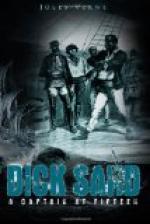“These admirable insects,” said he, without taking the trouble to find out if any one were listening—“these admirable insects belong to the marvelous order of newroptera, whose horns are longer than the head, the jaws very distinct, and whose lower wings are generally equal to the upper ones. Five tribes constitute this order: the Panorpates (scorpion flies), the Myrmileoniens, the Hemerobins, the Termitines and the Perlides. It is useless to add that the insects which now interest us, and whose dwelling we occupy, perhaps unduly, are the Termitines.”
At this moment Dick Sand listened very attentively to Cousin Benedict. Had the meeting with these termites excited in him the thought that he was perhaps on the African continent, without knowing by what chance he had arrived there? The young novice was very anxious to find out.
The savant, mounted on his favorite hobby, continued to ride it beautifully.
“Now these termitines,” said he, “are characterized by four joints on the instep, horned jaws, and remarkable strength. We have the mantispe species, the raphidie, and the termite species. The last is often known under the term of white ants, in which we count the deadly termite, the yellow corslet termite, the termite that shuns the light, the biter, the destroyer—”
“And those that constructed this ant-hill?” asked Dick Sand.
“They are the martial ants,” replied Cousin Benedict, who pronounced this word as if it had been the Macedonians, or some other ancient people brave in war. “Yes, the warlike ants, and of all sizes. Between Hercules and a dwarf the difference would be less than between the largest of these insects and the smallest. Among them are ‘workers’ of five millimeters in length ‘soldiers’ of ten, and males and females of twenty. We find also a kind otherwise very curious: the sirafous half an inch in length, which have pincers for jaws, and a head larger than the body, like the sharks. They are the sharks among insects, and in a fight between some sirafous and a shark, I would bet on the sirafous.”
“And where are these sirafous commonly observed?” then asked Dick Sand.
“In Africa,” replied Cousin Benedict; “in the central and southern provinces. Africa is, in fact, the country of ants. You should read what Livingstone says of them in the last notes reported by Stanley. More fortunate than myself, the doctor has witnessed a Homeric battle, joined between an army of black ants and an army of red ants. The latter, which are called ‘drivers,’ and which the natives name sirafous, were victorious.
“The others, the ‘tchoungous,’ took flight, carrying their eggs and their young, not without having bravely defended themselves. Never, according to Livingstone, never was the spirit of battle carried farther, either among men or beasts! With their tenacious jaws, which tear out the piece, these sirafous make the bravest man recoil. The largest animals—even lions and elephants—flee before them.




